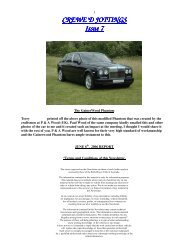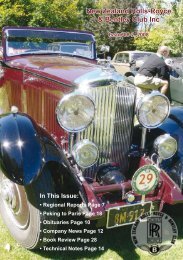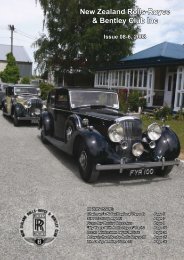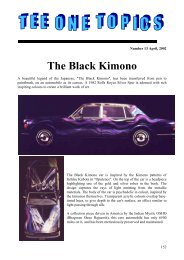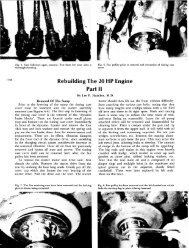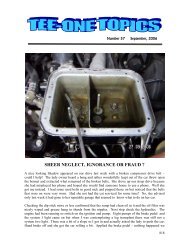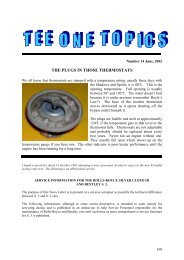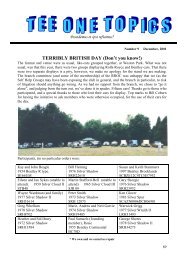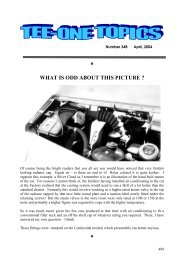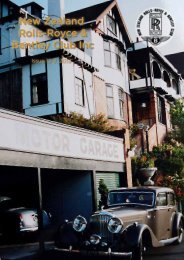April 2012 Newsletter - KDA132
April 2012 Newsletter - KDA132
April 2012 Newsletter - KDA132
Create successful ePaper yourself
Turn your PDF publications into a flip-book with our unique Google optimized e-Paper software.
Sir Frank Whittle and His Jet Engine by George Calder<br />
I never cease to wonder at modern jet travel as we fly around the<br />
world and have often wondered how the jet engine came about.<br />
Quite by chance I found the book Jet the Story of a Pioneer<br />
which is the autobiography of Frank Whittle which was published<br />
in 1958. I found it to be a fascinating story<br />
with Rolls-Royce having a role in the final<br />
development and production of the first jet<br />
engines..<br />
Every so often there are people who can<br />
think outside the square of what has gone<br />
before and have the ability to come up<br />
with a completely different way of doing<br />
something. These are the inventors, and<br />
Frank Whittle was one of them, and as a<br />
serving officer in the RAF came up with<br />
the idea of Jet propulsion for aeroplanes.<br />
From his initial idea to the jet engine being<br />
in useful service took 16 years and it was a struggle all the way to<br />
get the idea developed, tested and then into production. The whole<br />
enterprise was quite a saga, in some ways a sad and frustrating<br />
story for Whittle, but then finally recognition.<br />
Frank Whittle was interested in flight as a child and gained some<br />
engineering skills in the workshop of his father’s engineering<br />
business. In 1923, at the age of 16, he applied to the RAF to be<br />
an aircraft apprentice, and was accepted. During the three year<br />
apprenticeship, at which he did very well, he was involved in<br />
the base model aeroplane club and he credits this with his being<br />
given a Flight Cadetship to the RAF College at Cranwell when<br />
his apprenticeship was completed. This was a two year course of<br />
learning to fly and associated study and examinations. Each term<br />
required an assignment to be presented and for one assignment<br />
he chose the topic, “The future development of aircraft design”.<br />
This is where he started thinking about means of propulsion other<br />
than propellers driven by piston engines, which have limitations<br />
at high altitude. He therefore came up with the idea of a gas<br />
turbine, initially, he thought, to drive propellers. Meanwhile he<br />
was doing well with his flying and was credited as being the first<br />
cadet to successfully perform a ‘Bunt’ which apparently is the<br />
first half of an outside loop! He became part of a display team<br />
which would perform unusual flying manoeuvres and crashed two<br />
planes while practising. He was unhurt. In 1928 he was posted to<br />
a fighter squadron at Hornchurch as a Pilot Officer. He enjoyed<br />
his duties and claimed later on that it was the most carefree time<br />
of his life. During this time he continued to develop his ideas for<br />
a gas turbine engine and was given an opportunity to present them<br />
to the Air Ministry. He was given a fair hearing, but was later<br />
advised in writing that his theory was wrong, and there were no<br />
materials which could be applied to what he was proposing. The<br />
Air Ministry was therefore not interested. Whittle decided anyway<br />
to go ahead and patent his idea so it went out and was published<br />
throughout the world, rather than being kept secret as it should<br />
have been. The patent was registered in January 1930. Whittle’s<br />
idea was to have an engine with continuous combustion which<br />
would be used to provide thrust. Some of the combustion energy<br />
would be used to power a turbine which would drive a compressor<br />
to compress the air for the combustion.<br />
Whittle then tried to find private backing for his idea but had no<br />
luck. I think that it would be fair to say that he was quite obsessed<br />
about it and he talked incessantly to anyone who would listen.<br />
Even his student pilots learnt all about it! To the credit of the RAF<br />
they realized his inventive talents and posted him to positions<br />
which were testing new ideas. They also encouraged his further<br />
studies and broke some rules to send him to Cambridge University<br />
to complete a degree in Aeronautical Engineering.<br />
In 1935 his patent, for the Jet turbine, ran out and, as there<br />
seemed to be little prospect of getting it developed, and due to<br />
family financial commitments, he could not afford to renew the<br />
patent so he let it lapse. As fate would have it not long after he<br />
received a letter from an old Air Force associate from his training<br />
days advising that he knew someone who might be interested in<br />
trying to set up an enterprise to develop his idea. Whittle was<br />
sceptical as to whether anything would come of it. However, it<br />
did, and little by little the right people in high places got involved,<br />
investment bankers were found and a development company was<br />
set up. The company was called Power Jets Ltd and it had a very<br />
complex ownership involving the Air Ministry, The Investment<br />
Bank, private investors and Whittle, who was to stay on the Air<br />
Force payroll and oversee the business, so long as it did not<br />
interfere with his Air Force responsibilities! The company also<br />
took over the ownership of new patents which had been applied<br />
for. Power Jets’ task was to design, assemble, test and develop<br />
jet turbine engines for aeroplanes. The BT-H Company, Turbine<br />
and Electrical Engineers, in Rugby were contracted to make the<br />
major parts and Power Jets were assigned a space in their factory<br />
to do their work. Much work had to be done with only a small<br />
budget and it took some time to finalise the design, get all of the<br />
components from many different sub contractors and build the<br />
first prototype. Finally on the 12 <strong>April</strong> 1937 the jet turbine was<br />
ready for its first test run. Many BT-H personnel were on hand<br />
to assist and watch. The engine was started, which it did without<br />
any trouble. However, the RPM ran away out of control to a<br />
dangerous over speed, making a terrible screaming noise which<br />
of course had never been heard before. With this, all of the staff,<br />
helpers and watchers took to their heels running for cover in all<br />
directions. Only Whittle stayed at the controls frantically trying to<br />
stop the engine. Many changes were tried during the next weeks.<br />
However, the same thing occurred with each start up. Much was<br />
learned with these first tests and Whittle realised that further<br />
work would be required before he would have a workable engine.<br />
The first engine only had one combustion chamber and Whittle<br />
realized that multiple combustion chambers were required. It<br />
was a difficult time as funds were running low and much more<br />
money was needed. This took up a lot of time and energy getting<br />
the backing they needed to continue, but finally they had enough<br />
funds to build an engine with multiple combustion chambers. This<br />
new engine was finally completed and ready for testing in October<br />
1938. By this time they had been moved on from the main BT-<br />
H Company works to a disused foundry building at Lutterworth<br />
just north of Rugby which was owned by BT-H. The reason given<br />
by BT-H was that the Jet Engine work was too noisy, dangerous<br />
and disruptive to their main production which would come to a<br />
standstill when testing was being done!<br />
The development and testing carried on through 1938 and 1939<br />
with slow but steady progress. The main problem was that they<br />
lacked the equipment to make the changes they needed, and<br />
had to wait for sub contractors, which took up time. Also, the<br />
development was mostly done by trial and error as they lacked the<br />
test equipment which they needed to tell them what was happening.<br />
Finally in June 1939 the designed maximum speed of 16,000 rpm<br />
was achieved. It was an important month for the future of the<br />
Whittle Jet engine. The Air Ministry and other important official<br />
bodies responsible for research and development acknowledged<br />
the success of the Whittle engine as the way forward for aeroplane<br />
propulsion. An order was placed with the Power Jet Company for<br />
the first flight engine and an experimental aeroplane was ordered<br />
from the Gloster Aircraft Company. Then the war intervened.<br />
It was a very difficult time for Whittle and the ongoing development<br />
of the Jet engine. Whittle had hoped that the Air Ministry would<br />
set up Power Jets Ltd as the production operation to build the<br />
engines. However, this was not to be at the beginning of the war.<br />
The Air Ministry decided to keep Power Jets Ltd as consultants<br />
responsible for Design, Assembly of Prototypes, Testing and<br />
Development. The Air Ministry felt that there was already plenty<br />
of production capacity available elsewhere and orders for engines,<br />
to the Whittle design, were placed with BT-H and Rover Cars.<br />
Many problems arose with the initial production as both of these<br />
companies were not aeronautical engineers and just did not<br />
understand the importance of the weight of components and the<br />
NZRR&BC Issue 12-4 7



